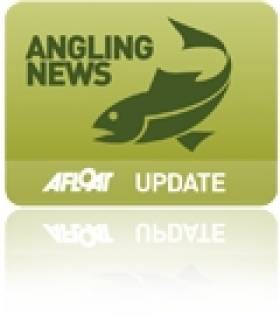Displaying items by tag: Creeslough
Major Angling Development on the River Lackagh, Co Donegal
#angling – Minister of State, Joe McHugh TD, visited the River Lackagh, Co Donegal, on Monday 20th October to view at first hand major angling development works currently underway to enhance this highly scenic salmon and sea trout fishery.
As part of an overall joint management plan for the development of the fishery, the Creeslough Angling Club, in conjunction with Inland Fisheries Ireland (IFI), have completed a major upgrade and expansion of angler access and car parking facilities along the lower reaches of the river near Creeslough village. The majority of the work was carried out by Tús community work placement workers, with materials and additional labour supplied by IFI.
Commenting on the visit, Minister McHugh said: "I had a very positive visit to the River Lackagh where I had an opportunity to see for myself the very encouraging development carried out on the upgrading and expansion of facilities at the fishery and the great work being carried out by all groups, including the Creeslough Angling Club, the IFI and on a broader level, the Donegal Angling Tourism Alliance.
"I would like to thank those present for giving clear and concise briefings on how developments are underway and outlining where they believe the future of angling for the River Lackagh and the surrounding lakes is heading. There are many opportunities here which are being pursued by local and national groups and I commend them on their hard work to date and look forward to working closer and supporting where I can, as Minister and within the Department of Communications, Energy and Natural Resources."
Previous developments on the fishery, funded mainly under the Salmon Conservation Fund administered by IFI, have seen a series of fishery and habitat enhancement measures completed including introduction of spawning gravels, fish passage improvement, selective bank clearance and erection of livestock fencing along key river bank sections. Salmon numbers have improved steadily on the fishery in recent years with the fishery re-opened on a 'catch and release' basis for the past two seasons.
Milton Matthews, Director, Inland Fisheries Ireland, briefed Minister McHugh on progress towards securing a major capital project for the fishery next year which would see a crump weir and fish counter facilities installed on the river. If successful, this proposal would represent the first such counter along the north Donegal coast.
Niall Gallagher, Paddy Boyle, chairman and secretary of the Creeslough AC, and consultant Kevin O'Connor, presented a copy of the 'Future Development plan for angling tourism and conservation of the Creeslough Fisheries to the Minister. The plan details future angling development proposals for the River Lackagh system and surrounding lakes including creation of additional angling spaces on the Owencarrow River, as well as provision of improved access, parking and mooring facilities at Glen Lough, Natooey and Roosky lakes.
The plan represents one of a number of similar projects developed by the Donegal Angling Tourism Alliance (DATA), a group formed in 2012 to promote game and sea angling in Donegal in partnership with Inland Fisheries Ireland.
Dr. Ciarán Byrne, CEO of Inland Fisheries Ireland, expressed his delight with achievements to date in Donegal, highlighting what can be achieved jointly by local angling clubs and interest groups working closely in partnership with IFI to secure development and long term sustainable management of fisheries. He commented: "Inland Fisheries Ireland is delighted to lend its support to the Donegal Angling Holidays initiative for the promotion of game and sea angling in the region."
Safari Boats Order Boosts Kerry Boat Building Firm
Kerry Boat-builder O'Sullivan's Marine (OSM) is bucking the trend in the depressed marine industry. The Tralee firm have a busy order book and report strong demand for its traditional lake boat marque but it also has interest in more exotic boats too for the emerging nature tourism market.

Tried and tested, the new Safari boats are ready for Lee Valley
The first of the orders processed in Tralee is the supply of four Pioner Multi boats with Motor Guide 24v Electric Outboards for the local Lee Valley Development, a new eight hectare (20 acre) eco-tourism development comprising a Nature Park. The four boats will be used for safari-style boat rides.
'We carried out water trials yesterday, all is in order and the fully fitted out boats are being delivered this week', says managing director Brian O'Sullivan.

OSM's Brian O'Sullivan with one of the new Pioner boats
OSM, a member of the Irish Marine Federation, is also supplying two lake boats to Creeslough Angling Association in Donegal. Six Irish built boats have also been ordered by Dunfanaghy Angling Association in Donegal. Five more lake boats are also going to Waterville, Co. Kerry. All orders are for November delivery! Recession? What recession?
OSM have a selection of used craft on the boats for sale website. See them here































































